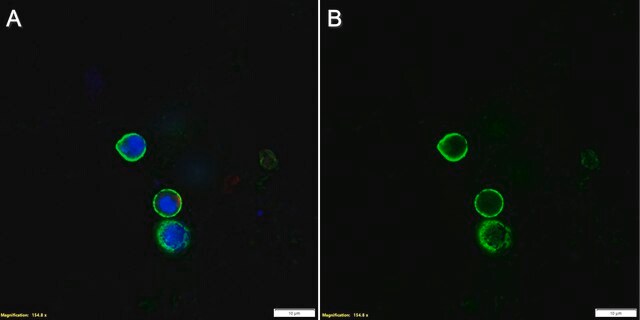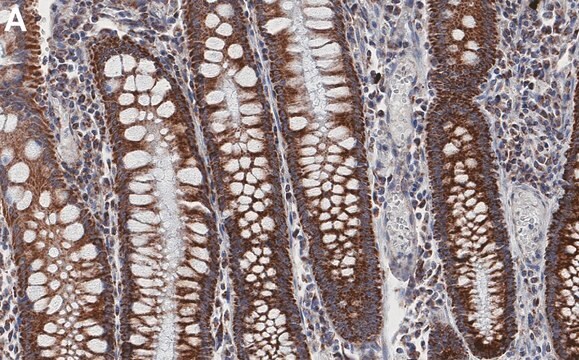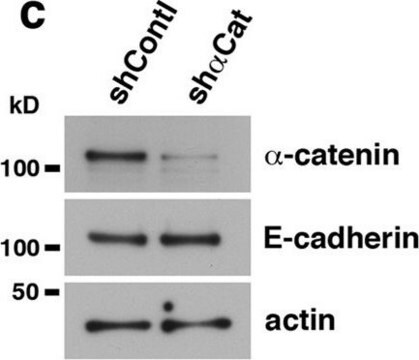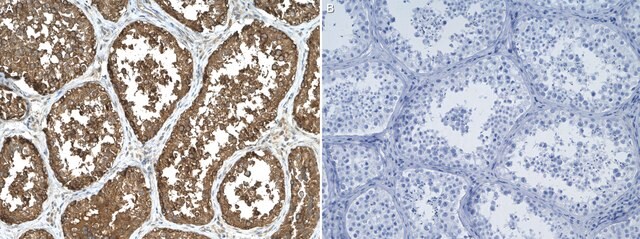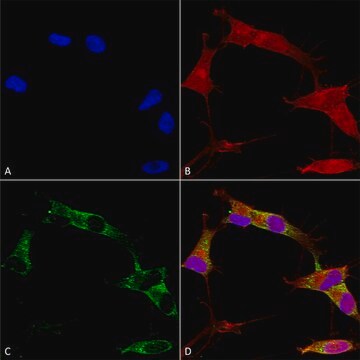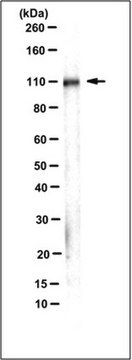일반 설명
We are committed to bringing you greener alternative products, which adhere to one or more of The 12 Principles of Green Chemistry. This antibody is Preservative-free, produced without the harm or sacrifice of animals and exceptionally stable to allow for ambient shipping and storage if needed and thus aligns with "Waste Prevention", "Designing Safer Chemicals" and "Design for Energy Efficiency".
Click here for more information.
ZooMAb® antibodies represent an entirely new generation of recombinant monoclonal antibodies. Each ZooMAb® antibody is manufactured using our proprietary recombinant expression system, purified to homogeneity, and precisely dispensed to produce robust and highly reproducible lot-to-lot consistency. Only top-performing clones are released for use by researchers. Each antibody is validated for high specificity and affinity across multiple applications, including its most commonly used application. ZooMAb® antibodies are reliably available and ready to ship when you need them.
특이성
Clone P4C10 is a ZooMAb® mouse recombinant monoclonal antibody that specifically detects Integrin β1/CD29. It targets an epitope within 12 amino acids from the extracellular domain.
면역원
Human fibrosarcoma HT-1080 cells.
애플리케이션
Quality Control Testing
Evaluated by Western Blotting in HeLa cell lysate (non-reduced).
Western Blotting Analysis: A 1:1,000 dilution of this antibody detected Integrin β1 in HeLa cell lysate (non-reduced).
Tested Applications
Flow Cytometry Analysis: 0.1 µg from a representative lot detected Integrin β1 in one million HeLa cells.
Immunocytochemistry Analysis: A 1:100 dilution from a representative lot detected Integrin β1in HeLa cells.
Note: Actual optimal working dilutions must be determined by end user as specimens, and experimental conditions may vary with the end user.
표적 설명
Integrin beta-1 (UniProt: P05556; also known as Fibronectin receptor subunit beta, Glycoprotein IIa, GPIIA, VLA-4 subunit beta, CD29) is encoded by the ITGB1 (also known as FNRB, MDF2, MSK12) gene (Gene ID: 3688) in human. Integrins are heterodimeric integral membrane proteins composed of a variable α-subunit and a conserved β-subunit that function in cell surface adhesion and signaling. They contain a large extracellular domain responsible for ligand binding, a single transmembrane domain, and a cytoplasmic domain. The exact combination of various α and β-subunits dictates the binding specificity of integrins to different ECM components. Although both subunits are required for adhesion, the binding specificity primarily depends on the extracellular portion of the α-subunit. Integrin β1 is a single-pass type I membrane glycoprotein that associates with one of the a subunits to form receptor for fibronectin. It recognizes the sequence R-G-D in a wide array of ligands. Five isoforms of integrin β1 have been described that are produced by alternative splicing. Integrin β1 is synthesized with a signal peptide (aa 1-20) that is subsequently cleaved off. The mature form has an extracellular domain (aa 21-728), a helical domain (aa 729-751) and a cytoplasmic region (aa 752-798). Isoform 1 of integrin β1 is widely expressed and other isoforms are generally co-expressed with a more restricted distribution. Isoform 2 is expressed in skin, liver, skeletal muscle, cardiac muscle, placenta, umbilical vein endothelial cells, neuroblastoma cells, lymphoma cells, hepatoma cells and astrocytoma cells. Isoform 3 and isoform 4 are expressed in muscle, kidney, liver, placenta, cervical epithelium, umbilical vein endothelial cells, fibroblast cells, embryonal kidney cells, platelets, and several blood cell lines. Isoform 4 is selectively expressed in peripheral T-cells and isoform 5 is expressed specifically in striated muscle (skeletal and cardiac muscle). Isoform 2 is reported to interfere with isoform 1 resulting in a dominant negative effect on cell adhesion and migration (in vitro). (Ref.: Balcaz, A., et al. (1993). J. Cell Biol. 121(1); 171-178; Altruda, F., et al. (1990). Gene. 95(2); 261-266).
물리적 형태
Purified recombinant mouse monoclonal antibody IgG, lyophilized in PBS, 5% Trehalose, normal appearance a coarse or translucent resin. The PBS/trehalose components in the ZooMAb formulation can have the appearance of a semi-solid (bead like gel) after lyophilization. This is a normal phenomenon. Please follow the recommended reconstitution procedure in the data sheet to dissolve the semi-solid, bead-like, gel-appearing material. The resulting antibody solution is completely stable and functional as proven by full functional testing. Contains no biocide or preservatives, such as azide, or any animal by-products. Larger pack sizes provided as multiples of 25 µL.
저장 및 안정성
Recommend storage of lyophilized product at 2-8°C; Before reconstitution, micro-centrifuge vials briefly to spin down material to bottom of the vial; Reconstitute each vial by adding 25 µL of filtered lab grade water or PBS; Reconstituted antibodies can be stored at 2-8°C, or -20°C for long term storage. Avoid repeated freeze-thaws.
기타 정보
Concentration: Please refer to the Certificate of Analysis for the lot-specific concentration.
법적 정보
ZooMAb is a registered trademark of Merck KGaA, Darmstadt, Germany
면책조항
Unless otherwise stated in our catalog or other company documentation accompanying the product(s), our products are intended for research use only and are not to be used for any other purpose, which includes but is not limited to, unauthorized commercial uses, in vitro diagnostic uses, ex vivo or in vivo therapeutic uses or any type of consumption or application to humans or animals.


